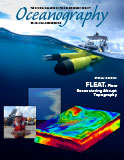Andres, M., M. Siegelman, V. Hormann, R.C. Musgrave, S.T. Merrifield, D.L. Rudnick, M.A. Merrifield, M.H. Alford, G. Voet, H.W. Wijesekera, and others. 2019. Eddies, topography, and the abyssal flow by the Kyushu-Palau Ridge near Velasco Reef. Oceanography 32(4):46–55, https://doi.org/10.5670/oceanog.2019.410.
Gula, J., M.J. Molemaker, and J.C. McWilliams. 2016. Topographic generation of submesoscale centrifugal instability and energy dissipation. Nature Communications 7, https://doi.org/10.1038/ncomms12811.
Johnston, T.M.S., J.A. MacKinnon, P.L. Colin, P.J. Haley Jr., P.F.J. Lermusiaux, A.J. Lucas, M.A. Merrifield, S.T. Merrifield, C. Mirabito, J.D. Nash, and others. 2019. Energy and momentum lost to wake eddies and lee waves generated by the North Equatorial Current and tidal flows at Peleliu, Palau. Oceanography 32(4):110–125, https://doi.org/10.5670/oceanog.2019.417.
MacKinnon, J.A., M.H. Alford, G. Voet, K. Zeiden, T.M.S. Johnston, M. Siegelman, S. Merrifield, and M. Merrifield. 2019. Eddy wake generation from broadband currents near Palau. Journal of Geophysical Research 124(7):4,891–4,903, https://doi.org/10.1029/2019JC014945.
Molemaker, M.J., J.C. McWilliams, and W.K. Dewar. 2015. Submesoscale instability and generation of mesoscale anticyclones near a separation of the California Undercurrent. Journal of Physical Oceanography 45:613–629, https://doi.org/10.1175/Jpo-D-13-0225.1.
Pinkel, R. 2012. Velocity imprecision in finite-beamwidth shipboard Doppler sonar: A first-generation correction algorithm. Journal of Atmospheric and Oceanic Technology 29:1,569–1,580, https://doi.org/10.1175/JTECH-D-12-00041.1.
Roshko, A. 1954. On the Development of Turbulent Wakes from Vortex Streets. National Advisory Committee for Aeronautics Report 1191, 25 pp.
Rudnick, D.L. 2001. On the skewness of vorticity in the upper ocean. Geophysical Research Letters 28:2,045–2,048, https://doi.org/10.1029/2000gl012265.
Rudnick, D.L. 2016. Ocean research enabled by underwater gliders. Annual Review of Marine Science 8:519–541, https://doi.org/10.1146/annurev-marine-122414-033913.
Salmon, R. 1998. Lectures on Geophysical Fluid Dynamics. Oxford University Press, New York, 378 pp.
Schönau, M.C., and D.L. Rudnick. 2015. Glider observations of the North Equatorial Current in the western tropical Pacific. Journal of Geophysical Research 120:3,586–3,605, https://doi.org/10.1002/2014JC010595.
Schönau, M.C., H.W. Wijesekera, W.J. Teague, P.L. Colin, G. Gopalakrishnan, D.L. Rudnick, B.D. Cornuelle, Z.R. Hallock, and D.W. Wang. 2019. The end of an El Niño: A view from Palau. Oceanography 32(4):32–45, https://doi.org/10.5670/oceanog.2019.409.
Shcherbina, A.Y., E.A. D’Asaro, C.M. Lee, J.M. Klymak, M.J. Molemaker, and J.C. McWilliams. 2013. Statistics of vertical vorticity, divergence, and strain in a developed submesoscale turbulence field. Geophysical Research Letters 40:4,706–4,711, https://doi.org/10.1002/grl.50919.
Sherman, J., R.E. Davis, W.B. Owens, and J. Valdes. 2001. The autonomous underwater glider “Spray.” IEEE Journal of Oceanic Engineering 26:437–446, https://doi.org/10.1109/48.972076.
Tennekes, H., and J.L. Lumley. 1972. A First Course in Turbulence. The MIT Press, Cambridge, 300 pp.
Zeiden, K.L., D.L. Rudnick, and J.A. MacKinnon. 2019. Glider observations of a mesoscale oceanic island wake. Journal of Physical Oceanography 49(9):2,217–2,235, https://doi.org/10.1175/JPO-D-18-0233.1.

